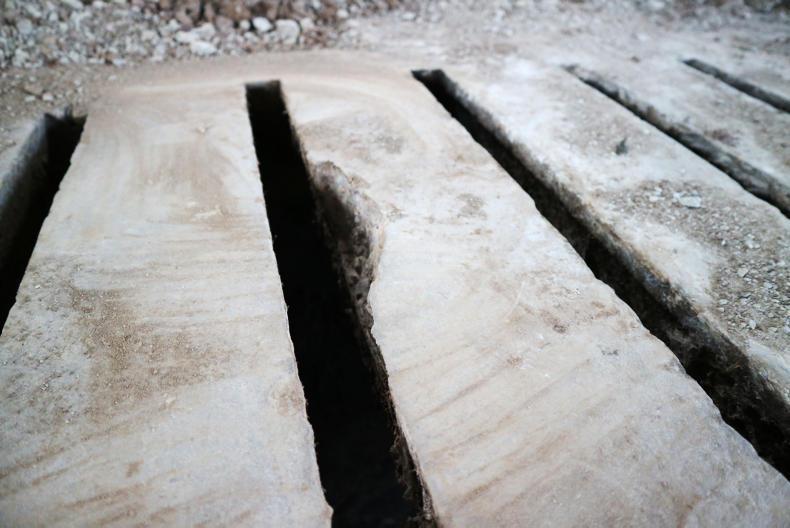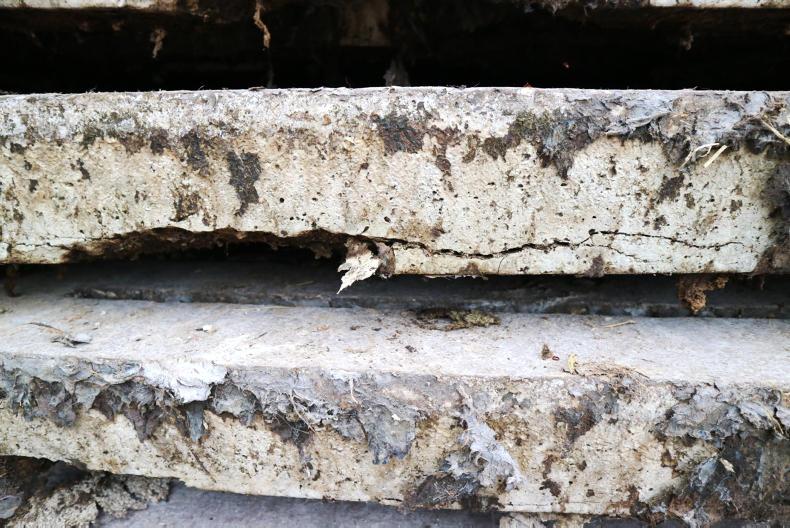When was your slatted or cubicle shed built? If it was one of the many sheds built in the 1980s or 1990s, and you have never replaced the slats on these sheds, now may be the time to do so.
A slatted shed is one of the most corrosive environments on a farm with a mixture of gases, moisture and slurry all reacting with concrete to slowly wear it down.
Every year, we hear incidences of slats failing and cattle slipping into tanks.
There can be particular problems where old slats may have had the reinforcing steel placed too close to the outer surface of the concrete.
This leaves the steel at an increased risk of corrosion, with the slat at risk of collapsing.
If there is a crack in the slat, this will allow slurry to come in contact with the steel. Over time the steel will then rust, weaken and swell.
This can cause the concrete to crack further and the strength of the slat will be lost.
Old slats
In the majority of cases, slats can look like they are in good condition from the top. However, it is once you look at the underside that the issues become apparent.
One of the first things that can be done is to get a straight edge and lay it across the centre of the slats. You will quickly be able to see if the slats are beginning to sag at the centre.
Where slats are covered with rubber mats it is important to remove these to get a good inspection of the slats.
A simple inspection kit can be purchased for €7 to €10 and will include a small light and mirror
Look out for any cracks or chips on the surface, while cleaning down between the gaps may also help to identify any corrosion or faults.
Another indicator to look out for are chunks of concrete out in the fields after slurry has been spread, which may have come off the underside of the slats.

Corrosion can happen where the reinforcing steel has been placed close to the surface of the slat.
A simple inspection kit can be purchased for €7 to €10 and will include a small light and mirror.
While it may be difficult to get a good view of the underside, it can help to see if there are cracks on the side of the slats.
Grant aid
Farmers are eligible to receive grant aid through the Targeted Agricultural Modernisation Scheme (TAMS) when replacing existing slats on their farm.
It is vital when laying new slats that they are free from any cracks, honeycombing or chips on the top corner.
They must have a full bearing of at least 150mm at points of support and the finished slat floor must be level and free from any rocking.
It is worth consulting the Department specifications S123 and S123S if you are thinking of replacing slats.

Look out for any structural damage to slats.
You should be able to replace them with minimum disturbance as they have a limited working life, much shorter than that of the shed.
One issue that farmers have encountered is where cubicle beds have been positioned on slats and the difficulty that then arises when slats need replacing.
Where it is necessary to construct cubicle over slats, then precast cubicle beds must be used
Standard cubicle beds must not be built directly on to new replacement slats.
Where it is necessary to construct cubicle over slats, then precast cubicle beds must be used. The slats under the precast cubicle beds must also be heavy-duty.
Where machinery has to pass over a tank on a regular basis, it is better if possible to use slabs, rather than heavy-duty slats, as they will have a longer working life and are at least the same strength.
Farmers should never enter a slatted tank, even if it is empty, without the appropriate breathing apparatus.
In many cases, slat manufacturers will offer to view slats free of charge and they can give an assessment of the quality of the slat.
When was your slatted or cubicle shed built? If it was one of the many sheds built in the 1980s or 1990s, and you have never replaced the slats on these sheds, now may be the time to do so.
A slatted shed is one of the most corrosive environments on a farm with a mixture of gases, moisture and slurry all reacting with concrete to slowly wear it down.
Every year, we hear incidences of slats failing and cattle slipping into tanks.
There can be particular problems where old slats may have had the reinforcing steel placed too close to the outer surface of the concrete.
This leaves the steel at an increased risk of corrosion, with the slat at risk of collapsing.
If there is a crack in the slat, this will allow slurry to come in contact with the steel. Over time the steel will then rust, weaken and swell.
This can cause the concrete to crack further and the strength of the slat will be lost.
Old slats
In the majority of cases, slats can look like they are in good condition from the top. However, it is once you look at the underside that the issues become apparent.
One of the first things that can be done is to get a straight edge and lay it across the centre of the slats. You will quickly be able to see if the slats are beginning to sag at the centre.
Where slats are covered with rubber mats it is important to remove these to get a good inspection of the slats.
A simple inspection kit can be purchased for €7 to €10 and will include a small light and mirror
Look out for any cracks or chips on the surface, while cleaning down between the gaps may also help to identify any corrosion or faults.
Another indicator to look out for are chunks of concrete out in the fields after slurry has been spread, which may have come off the underside of the slats.

Corrosion can happen where the reinforcing steel has been placed close to the surface of the slat.
A simple inspection kit can be purchased for €7 to €10 and will include a small light and mirror.
While it may be difficult to get a good view of the underside, it can help to see if there are cracks on the side of the slats.
Grant aid
Farmers are eligible to receive grant aid through the Targeted Agricultural Modernisation Scheme (TAMS) when replacing existing slats on their farm.
It is vital when laying new slats that they are free from any cracks, honeycombing or chips on the top corner.
They must have a full bearing of at least 150mm at points of support and the finished slat floor must be level and free from any rocking.
It is worth consulting the Department specifications S123 and S123S if you are thinking of replacing slats.

Look out for any structural damage to slats.
You should be able to replace them with minimum disturbance as they have a limited working life, much shorter than that of the shed.
One issue that farmers have encountered is where cubicle beds have been positioned on slats and the difficulty that then arises when slats need replacing.
Where it is necessary to construct cubicle over slats, then precast cubicle beds must be used
Standard cubicle beds must not be built directly on to new replacement slats.
Where it is necessary to construct cubicle over slats, then precast cubicle beds must be used. The slats under the precast cubicle beds must also be heavy-duty.
Where machinery has to pass over a tank on a regular basis, it is better if possible to use slabs, rather than heavy-duty slats, as they will have a longer working life and are at least the same strength.
Farmers should never enter a slatted tank, even if it is empty, without the appropriate breathing apparatus.
In many cases, slat manufacturers will offer to view slats free of charge and they can give an assessment of the quality of the slat.








 This is a subscriber-only article
This is a subscriber-only article









SHARING OPTIONS: